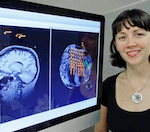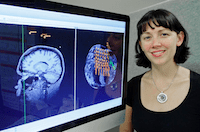Tennis elbow (known in medical terms as lateral epicondylalgia) is a common condition that presents with pain on the outer aspect of the elbow. Despite its name, the condition is not restricted to tennis players and can affect anyone performing repetitive movements of the forearm (manual labourers, typists etc). In fact, tennis elbow affects up to 15 % of workers [1] and in many cases, symptoms persist and recur despite treatment.
Historically, tennis elbow was thought to be a problem restricted to the tendon (of the extensor carpi radialis brevis muscle) on the outer aspect of the elbow. However, in recent years a number of studies have shown symptoms in tennis elbow that do not fit with the description of this condition as a local tendon problem. For example, changes in movement and sensation are present in muscles unrelated to the condition (e.g. muscles of the upper arm), and these changes often appear in the opposite (or ‘unaffected’) arm [2-4]. The distribution of these symptoms across the midline points to a role for the brain in the persistence of elbow pain.
Consistent with this hypothesis, we have shown that the regions of the brain controlling movement of the forearm muscles have much greater activity and are more overlapped or ‘smudged’, than in people who are pain-free [5]. These brain changes seem to be associated with the duration and severity of symptoms and could explain the persistence and recurrence of symptoms in this condition [5].
Further support for this idea comes from our recent work that has shown altered inhibitory and facilitatory mechanisms, known to regulate activity and overlap in motor brain regions, in tennis elbow. Specifically, we have shown that people with tennis elbow have less inhibition and less facilitation in the motor regions of the brain [6]. Put simply, this means that the mechanisms that usually help to regulate brain activity are out of balance in tennis elbow, and this could underpin the increase in brain activity and overlap that we observe in this condition.
Although further studies are needed to determine whether changes in the brain are a cause or a consequence of long-term elbow pain, there is the possibility that treatments directed at rebalancing the brain (e.g. forms of non-invasive brain stimulation, electrical stimulation at the elbow or movement retraining) might help to alleviate symptoms in this common condition. Our research team is beginning to trial these treatments to see how useful they are in people with tennis elbow.
Passionate about pain and the brain? Want to contribute to our understanding of why some people get persistent pain and help design new treatments?
If you have musculoskeletal pain (of any form – e.g. elbow, back, knee) and live in Sydney contact us to find out about what research is on-going and that is looking for volunteers.
PhD Scholarship available
We are also looking for a highly motivated individual to undertake a full-time PhD scholarship (fully funded for 3 years) with our team. You will join an active research group at Western Sydney University (Brain Rehabilitation and Neuroplasticity Unit), benefiting from engagement with top researchers in the fields of brain plasticity and pain. You will gain skills and knowledge in transcranial magnetic stimulation to measure neuroplasticity in the human brain, neuronavigation, phlebotomy, central sensitisation, pharmacology and musculoskeletal pain. For more information or to apply, please send a CV to s.schabrun@uws.edu.au.
About Siobhan Schabrun
 Siobhan is a NHMRC Career Development Fellow and 2014-2015 Fulbright Scholar at Western Sydney University. After blending a degree in physiotherapy with a PhD in neuroscience, she is passionate about understanding, treating and preventing persistent pain. Her research has a particular focus on that buzzword… ‘neuroplasticity’. Siobhan was the winner of the inaugural Australasian Brain Stimulation Conference joke contest – which says something about her sense of humour…
Siobhan is a NHMRC Career Development Fellow and 2014-2015 Fulbright Scholar at Western Sydney University. After blending a degree in physiotherapy with a PhD in neuroscience, she is passionate about understanding, treating and preventing persistent pain. Her research has a particular focus on that buzzword… ‘neuroplasticity’. Siobhan was the winner of the inaugural Australasian Brain Stimulation Conference joke contest – which says something about her sense of humour…
References
[1] Shiri R, Viikari-Juntura E, Varonen H, Heliovaara M. Prevalence and determinants of lateral and medial epicondylitis: a population study. Am J Epidemiol. 2006;164(11):1065-74. doi: 10.1093/aje/kwj325. PubMed PMID: 16968862.
[2] Bisset LM, Russell T, Bradley S, Ha B, Vicenzino BT. Bilateral sensorimotor abnormalities in unilateral lateral epicondylalgia. Arch Phys Med Rehabil. 2006;87(4):490-5. doi: 10.1016/j.apmr.2005.11.029. PubMed PMID: 16571387.
[3] Pienimaki TT, Kauranen K, Vanharanta H. Bilaterally decreased motor performance of arms in patients with chronic tennis elbow. Arch Phys Med Rehabil. 1997;78(10):1092-5. PubMed PMID: 9339158.
[4] Alizadehkhaiyat O, Fisher AC, Kemp GJ, Vishwanathan K, Frostick SP. Upper limb muscle imbalance in tennis elbow: a functional and electromyographic assessment. J Orthop Res. 2007;25(12):1651-7. doi: 10.1002/jor.20458. PubMed PMID: 17600835.
[5] Schabrun SM, Hodges PW, Vicenzino B, Jones E, Chipchase LS. Novel Adaptations in Motor Cortical Maps: The Relationship to Persistent Elbow Pain. Med Sci Sports Exerc. 2014;Epub ahead of print. Epub Aug 6.
[6] Burns E, Chipchase LS, Schabrun SM. Altered function of intracortical networks in chronic lateral epicondylalgia. Eur J Pain. 2016. doi: 10.1002/ejp.841. PubMed PMID: 26871462.



